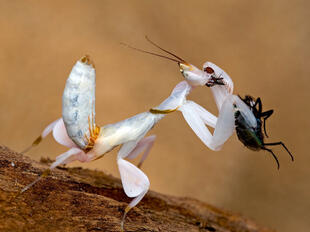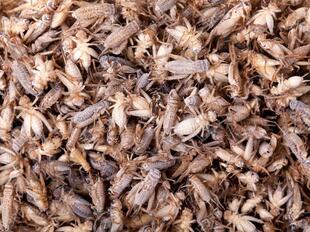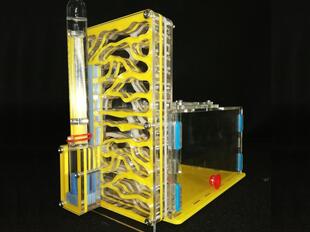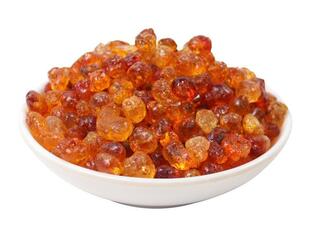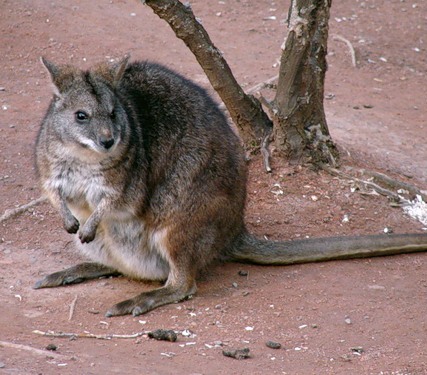
Parma wallaby(Macropus parma)
Phylum —chordata
Class — mammalia
Order — diprotodontia
Family — macropodidae
Genus – macropus
Appearance
The Parma wallaby is the smallest member of the genus Macropus, at between 3.2 and 5.8 kg (7.1 and 12.8 lb), less than one tenth the size of the largest surviving member, the Red kangaroo. It is about 0.5 m (1.6 ft) in length, with a sparsely furred, blackish tail about the same length again. The fur is a reddish or greyish brown above, greyer about the head, and fading to pale grey underneath.
Habitat
The Parma wallaby is a native of the Great Dividing Range, which is between the Watagan Mountains and the Gibraltar Range in Eastern Australia. It lives only in New South Wales, occupying wet, sclerophyll forests that have grassy openings and thick undergrowth.
Behavior
Parma wallabies are solitary, cryptic creatures. They are nocturnal, although sometimes they are active at dawn or dusk, spending the day sheltering under cover. Soon after waking at dusk, they start feeding, usually gathering in groups of two or three individuals to forage. Most social interactions occur at sunrise, when their activity peaks. These animals are bipeds and they move with a hopping type of gait, with their tail acting as a counterbalance. When resting they will often sit “tripod style,” being balanced on their hind legs and tail. They communicate visually, with tail wagging, quivering, and foot stomping to signal aggression. They will also communicate with their mates by clucking, or coughing, with hissing as another sign of aggression.
Diet
A Parma wallaby is a herbivore and feeds mainly on herbaceous plant parts and reedy grasses.
Reproduction
These wallabies are polygynandrous (promiscuous), two or more males mating with two or more female wallabies. They breed between the months of March and July, and produce one offspring each breeding season. Gestation is for about 35 days. The newborn remains in its mother’s pouch. After 30 weeks it is ready to leave the pouch, but continues to nurse until 10 months. Since the Parma wallaby is a solitary creature, the only interactions between adult males and females are when they mate. Males take no part in caring for young. A female reaches sexual maturity at about 16 months, and males between 20-24 months.
In the wild, the expected lifespan of Macropusparma is 6 to 8 years. In captivity, their expected lifespan is 11 to 15 years.
Incaptivity
A common formula to determine a nicely-sized outdoor enclosure is to make the minimum height and width four times the length of your wallaby; make the length of your enclosure eight times the length of your wallaby. This size will need to increase exponentially if you have more than one wallaby.
These animals do well in both warm and cool weather, but they will need supplemental heat or to be housed indoors when temperatures drop below 50 degrees Fahrenheit. They can live outside in warm months or year-round if they have a dog house with supplemental heat to use as a retreat. Since wallabies are small, they can be kept indoors and allowed to run around in a safe environment. When unsupervised, they can even be kept in a secure, large enclosure or small bedroom.
There are a variety of food options for pet wallabies. If not allowed the natural diet, your pet's digestive system can be upset with very serious consequences, much like the deadly condition of ileus in pet rabbits.
Unlimited fresh, chemical-free grass, sweetgrass, orchard grass, or timothy hay should be available at all times. This mainly grass-based diet should then be supplemented with wallaby pellets and a few fresh green vegetables and fruits like apples and grapes; avoid very sweet fruits. Some breeders recommend a small amount of monkey chow in addition to wallaby pellets. If wallaby pellets are not available then rabbit or horse pellets may be used, but they are not the best choice.
Feed your wallaby to achieve an ideal body condition score. To provide a complete and balanced diet, place a mineral block in the enclosure; vitamin E and selenium supplements should also be added to your wallaby's food. If your wallaby spends time outside, it will likely graze and eat the grass or plants in its enclosure. Make sure there are no toxic plants in the area and that nothing in the yard has been treated with pesticides or chemicals.
 Russian
Russian
 English
English




















